A conversation with Peter Tepe | Section: Interviews
Abstract: This article is a conversation with the artist Anna Lena Grau, whose exhibition Gespinste does not only refer to science but is itself part of an anatomical collection. Grau exhibits her wax-made objects alongside objects of the permanent collection. In doing so, she intends to re-encode body parts; an approach which stands in opposition to the scientific aim of objectification. Grau therefore attempts, through artistic means, to rectify common judgements of body parts and regions.
Anna Lena Grau, our online journal not only serves as a stage for this interview, but also for presenting your installation Gespinste (Interweavings). It is this project that will be the main topic of our conversation. The illustrations that are part of the art presentation will not be reproduced again with the artist interview. Just a few further reproductions will be added. Where and when did the exhibition take place?
The exhibition took place from 15 June to 4 July 2013 as part of the exhibition series Kunstinfekte (Art Infections) hosted by the Anatomical Collection of Erlangen.
These exhibitions have taken place every two years on the premises of the Anatomical Institute. Amongst the invited guests were physicians who actively pursue art and artists with an active interest in medicine. The self-taught in the field of art encountered the self-taught in the field of medicine. On these occasions, ambitious dilettantes came face to face with professionals, each party certainly fostering a sense of discomfort in the other.
The exhibition series was initiated by the Anatomical Institute (under the auspices of Dr. Winfried Neuhuber) and by the Hamburg dance school KOÏNZI-DANCE Interdisziplinäre Kunst Hamburg e.V. However, as I am informed, it is unlikely that this exhibition series will be continued in the near future due to changes in the institute’s management in the coming year.
Your installation is of interest for w/k in two respects: firstly, it was located within a scientific collection; secondly, it makes direct reference to objects in this collection. The aim of this interview is to discuss the specific scientific relevance of your work and thereby deepen our understanding of your works of art and your procedural method.
I must say straightaway that I don’t consider myself as an artist who works in a scientific way. Although I make references to the surrounding scientific collection in my installation − as well as to archaeological findings and scientific experimental apparatus − I do not work along the lines of scientific research in the classical sense, by which I mean how a certain working hypothesis is proposed and then gradually tested to the core.
By contrast, my approach is more associative and intuitive: I take detours, stumblingly grope my way in the dark. My installations are intended to leave a lot of scope for association. My purpose is not to give the single correct answer, but to provoke questions. I would like to make things come alive under the magnifying glass.
At this point may I briefly digress to avoid a misunderstanding about the terminology used in the online journal?
Go ahead.
As scientifically pertinent artists we define all artists who base their artistic work on scientific theories and/or methods, and/or results of one type or another. Since an anatomy collection is the product of a specific branch of scientific work, we would, for this project at least, describe you as a scientifically pertinent artist.
When it comes to scientifically pertinent artists, we also distinguish between several variations. Here I will restrict myself to just two variations. Certain artists work predominantly or exclusively in a science-related way, others adopt a scientific approach only for a selected few projects, maybe only for one. Hence some artists base their work on scientific principles, others don’t. Taking these distinctions into account, one could say that you adopt a scientifically oriented approach in some of your projects but not in all of them. In these, rather than working according to the standards of scientific research, you proceed intuitively.
You could say that.
What did you do to get your work exhibited at the Anatomical Collection in Erlangen?
Nothing actually. It was Dr. Neuhuber who asked me whether I’d like to participate. He had seen some of my early works that fitted well with the collection’s exhibition series. His invitation was related to a series of glass sculptures I had created in homage to Leopold (1822−1895) and Rudolf Blaschka (1857−1939).
The Blaschkas, father and son, were glassblowers. During the 19th century they created highly detailed glass models of marine animals that, in terms of the level of development at the time − and of scientific research − represented extraordinary innovations, even though the Blaschkas weren’t scientific taxidermists. In 2007, one year before I finished studying at the Hochschule für Bildende Künste (University of Fine Arts) in Hamburg, I came across their work on a visit I made to the Vienna Museum of Natural History where some of their models of jellyfish are exhibited. I was fascinated by the fusion they had achieved, between glass and jellyfish, between research and craftsmanship. After that I began to take an intense interest in the formal language of mathematical and scientific models. I designed my own spatial models for installations and sculptures that echo certain motifs such as the Klein bottle by Felix Klein (1849−1925) or that of the coral featured in the early evolutionary model developed by Charles Darwin (1809−1882).
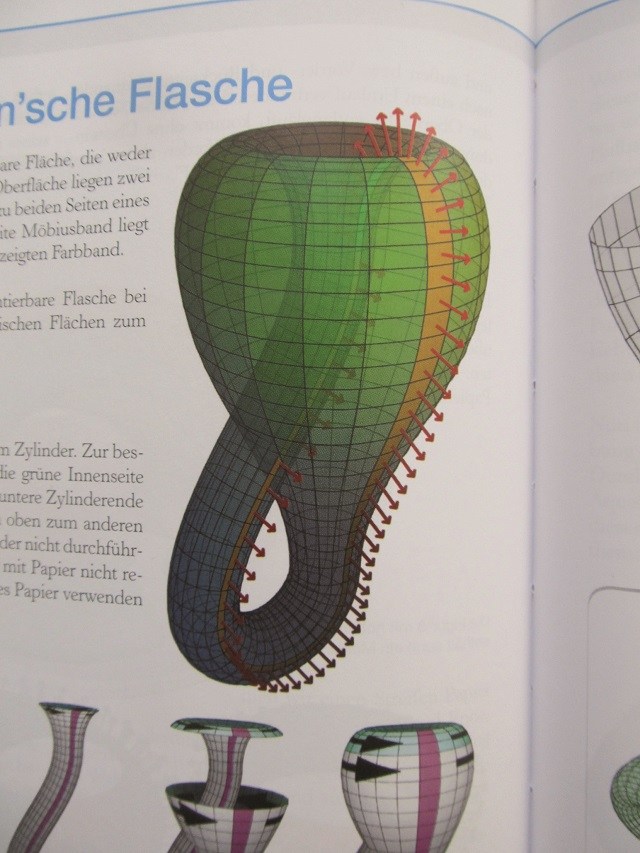
Depiction of the Kleinsche Flasche Source: Georg Glaeser, Konrad Polthier. 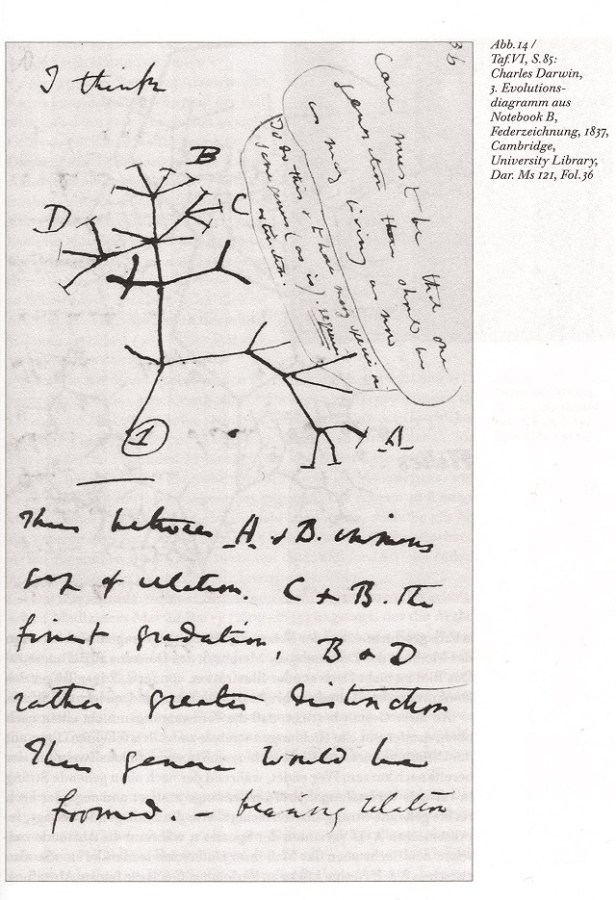
Charles Darwin: evolution chart from 1837. Source: Horst Bredekamp. 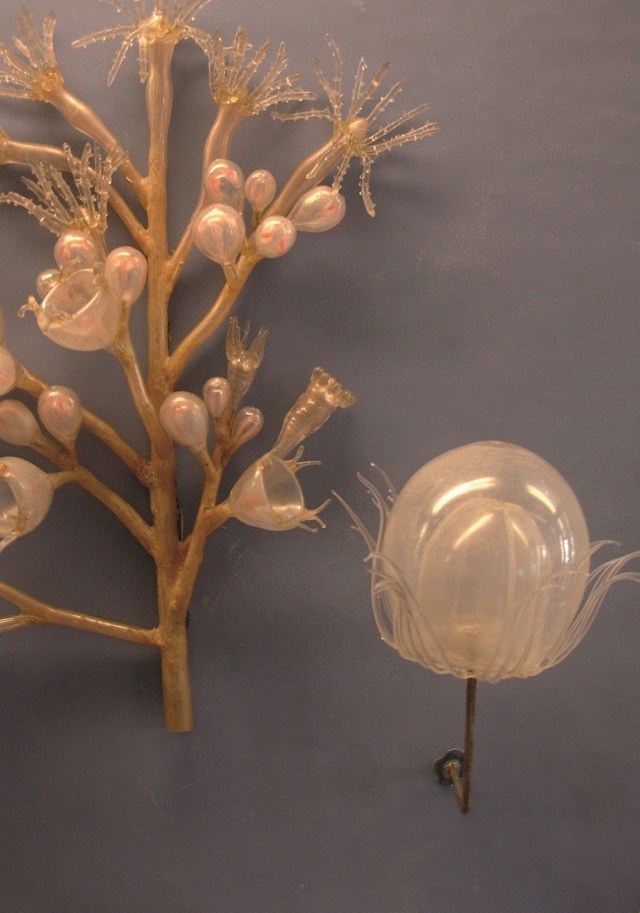
Modelle Blaschka. Photo: Astrid von Poschinger.
Let’s get back to your installation at the Anatomical Collection in Erlangen. How would you describe this collection?
It’s a classical institute collection. It comprises the larger New Collection and the smaller Old Collection, located in two neighbouring venues. The New Collection, where my installation was held, contains materials for teaching medicine: models, wet specimens and bone preparations that illustrate the development and the build of the human body. Some of them date back to the 19th century, but there are also a lot of more recent elements such as preparations produced during student seminars.
The Old Collection has a historical focus. Precious items, tools and curiosities are crammed together in antique wooden display cabinets. Amongst the exhibits are masterpieces by the institute’s preparators with which it is possible to reconstruct both historical and modern preparation techniques. This part of the collection is dedicated to the history of the institute with all its positive and more sombre aspects.
What do you mean by sombre aspects?
Notions of legality concerning the sources of human preparations have fundamentally changed over the last 100 years. This is well described in a text by Dr. Susanne Ude-Koeller that was published as part of the chronicle 200 Jahre Universitätsklinikum Erlangen 1815−2015 (Böhlau Verlag, Cologne/Weimar/Vienna, 2016).
Nowadays, the need for human body material is met entirely by body donors, that is, people who during their lifetime pledged their bodies to anatomical research after their deaths. But earlier in the 20th century access to dead bodies was determined by official regulations. Thus, in particular, prisons and poorhouses were called upon to deliver the bodies of the deceased to the anatomical institutes which were constantly “short of corpses”. This assumed dramatic proportions during the Nazi era. A provision issued on 18 February 1939 by the Reichsminister of Science, Education and National Culture as part of new regulations concerning the enforcement of the death penalty declared sites of execution the main suppliers for anatomical institutes.
Do you consider it an integral component of your preparation phase to more deeply explore the scientific problems and procedures that are of concern to and are applied by the people working in the collection?
Yes and no. Even though I have attended neither anatomical preparation classes nor lectures on anatomy, I’ve engaged in some intense discussions with the institute’s director and also went to the state library from time to time to read up certain questions. Aside from ethical aspects − relating, for instance, to the issue of legal origin I mentioned before − I was mainly interested in technical parallels with relief casting techniques. Preparators and artists actually adopt very similar techniques. To prepare a cast, the metal caster furnishes a wax form with wax placeholders that serve as the so-called sprues allowing the molten metal to flow into and spread equally inside the cast. An anatomical preparator uses a similar technique when turning an organ’s veins and smaller vessels into casting moulds, reproducing the organ in wax, plastic or metal by applying the “lost-wax” technique.
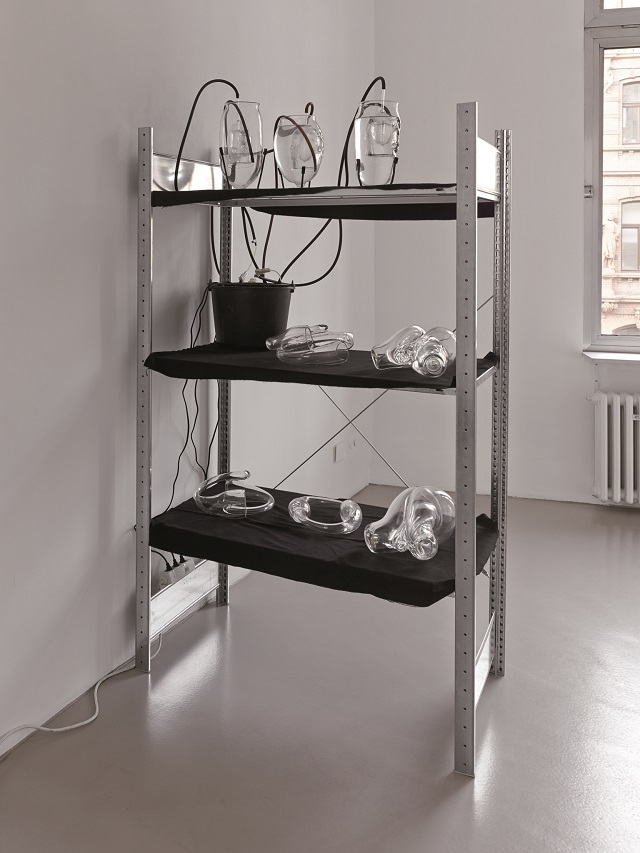
Anna Lena Grau: Tränengläser (2003), Helix (2012) and Seychellen (2008). Photo: Simon Vogel. 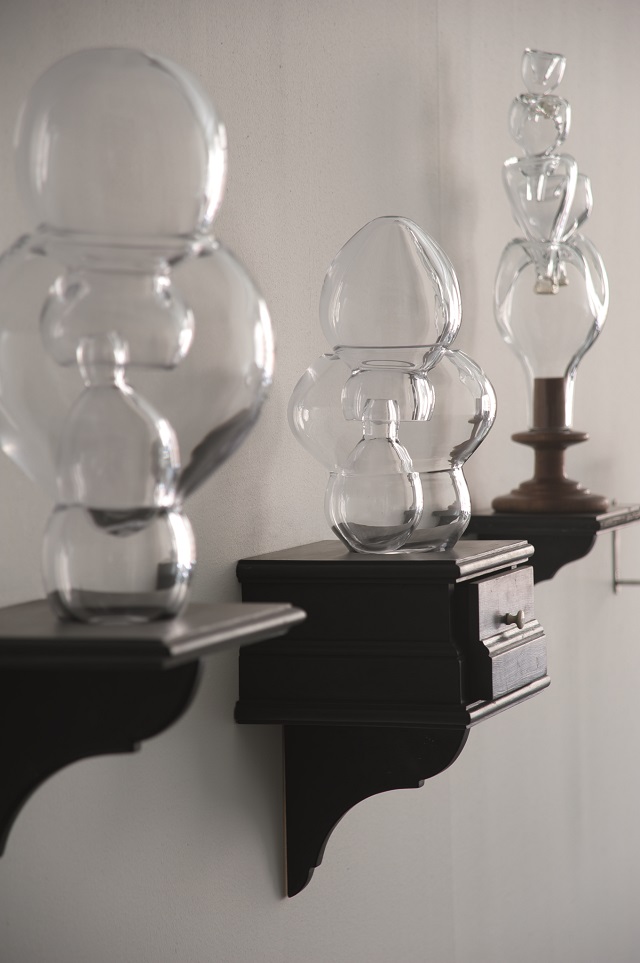
Anna Lena Grau: Schneemanngläser and Quallenbäume (2008). Photo: Ottmar von Poschinger. 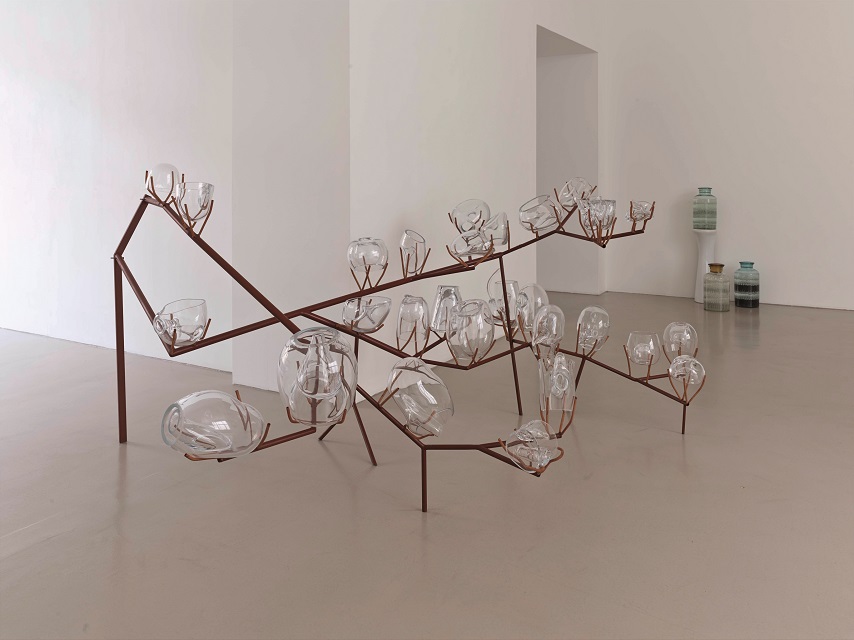
Anna Lena Grau: Wenn Narziss und Echo sich küssen (2007). Photo: Simon Vogel.
Now let’s talk about your way of working in the collection. Are there any objects in the anatomical collection that particularly fascinated you and inspired you to give an artistic response?
Yes. Each of my wax objects corresponds to an object in the collection on which, to a certain extent, I based a particular model. My artistic goal was not only to reproduce an object from the collection in wax, but I also aspired towards some kind of reanimation or recoding of body parts.
What exactly do you mean by that?
I feel I should digress a little to answer that question in a satisfactory manner. The preparations exhibited in an anatomical collection show the bodies and body parts of human beings that were once alive. It is my theory that here, however, they’re no longer supposed to be perceived as such. They have been isolated from the process of growth and decay, and of natural metamorphosis during which the body decomposes to give birth to new life.
Bodies and body parts are preserved by applying hygienically regulated conservation techniques. In my opinion, removing something in this way from a natural process is more than simply suspending it into a fixed state, for this too is always a form of transformation. The body becomes a preparation, teaching material, a scientific object kept in archives, showcases and glass cabinets. That’s why I regard the production of anatomical preparations as a recoding of a specific body or its parts: they are assigned new significance as scientific objects. To pursue this process requires discarding the subject to which the body once belonged.
What does this mean concretely with regard to the works presented in the exhibition Gespinste?
My idea was to present a counter-concept to the objectification sought in anatomical collections. In the group of works Galatea/Gussbaum 1−13 (Galatea/Casting Tree 1−13) I tried to restore some of the original individuality and specific impact of the body parts through a different kind of recoding.
Is there a connection to Ovid’s Galatea in Metamorphoses?
Yes, exactly. I refer to the statue that is brought to life. For those who don’t know the story, a shortened version of it goes like this: a sculptor named Pygmalion, disillusioned with the world, has retired to his studio and works on an ivory statue intended to represent the perfect woman. Over time, he treats the effigy more and more like a real person and finally falls in love with his own creation. On asking Venus to grant him his wish that his future wife perfectly resemble the effigy, the statue suddenly comes alive.
The fact that, for my Galatea group I take single body parts from an anatomical collection as models, reproducing them in wax, stands in clear contrast to the perfect woman described by Ovid − set pieces, segments, sections, fragments, that’s all there is.
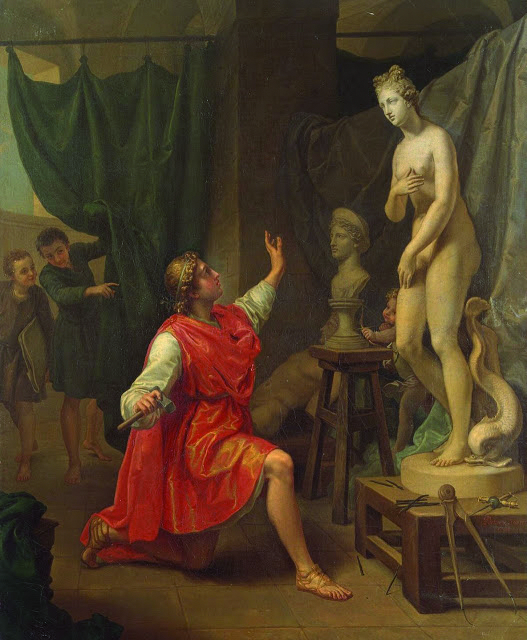
Laurent Pecheux: Galatea and Pygmalion (1780). Source: Wikimedia Commons. 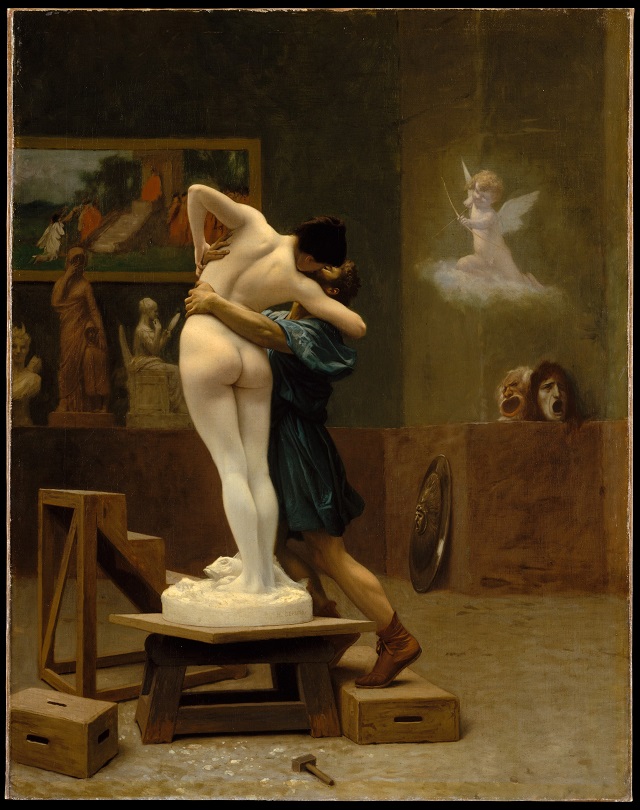
Jean Léon Gérôme: Galatea und Pygmalion (ca. 1890). Source: Wikimedia Commons.
Why did you choose the double title?
Each Galatea is also a numbered casting tree. I’ve melded the corporeal elements with technical applications that are also used for bronze casts, including the wax funnels and the “sprues” used for the lost-wax casting technique I mentioned above. By doing so, I obtained fully functional wax casting trees which can be connected to a casting mould. The body parts within the casting trees thus themselves became channels for a potential relief casting. So the double title alludes to a dual function or an ambiguity of the sculptures.
Does this ambiguity relate to the artistic recoding of individual body parts?
Yes, the new context of the copied body part in a sculpture (or is it a casting tree?) generates new codings − accompanied by a new space of reflection. My sculptures are at an intersection between mechanics and organic chemistry, between physics and metamorphosis.
The casting trees are peculiarly morphological. On the one hand, this aspect is brought about by the material wax that in its colouring and natural transparency is reminiscent of the human body, on the other hand, by the shape of the casting trees: their appearance is quite strange. The sprues, sitting atop the cast funnels, seem like arms reaching out for the potential cast object. The organs in between make up the trunk of the figure: heart, kidney, eye. Every single casting tree has its own individual character.
From my point of view, these casting trees manifest a certain liveliness. The mud is whirled up a little, the body parts are no longer simply objects in showcases: they look at you, reach out for you…
It is as if you are contradicting the Pygmalion myth of the coming to life of a whole statue. As for this work, is there a particular reason why you concentrate on individual parts of the human body?
From my perspective as an artist I seek to summon a rapport of empathy towards body parts that frequently make other people feel disconcerted and uneasy. I try to counter the disconcertment and unease by, for example, treating the large intestine in exactly the same way as I would the eyeball.
Is that to say you use artistic means to try to correct widespread perceptions of parts and areas of the body?
Precisely. I seek − for a moment at least − to unhinge the hierarchical order and perceived value of different body parts so as to give them an equal presence on the same stage. In this context, it should not go unmentioned that I have a strong aversion to exaggerated notions of hygiene and order that are all too often misused to stigmatise individuals or whole groups of the population. Hence I also call into question established ideas of perfection and imperfection.
Can you explain in a little more detail your idea of recoding bodies or body parts?
I understand the term “recoding” in a wide sense. My explanation is based on the assumption that everyone of us plays different roles day by day − within the family, at work, in public. Every day we perform a little bit on our own personal stage. Consequently, this might be interpreted in the way that these various roles involve different codings of one’s own body and those of other individuals. Taking the body as a starting point, one could say that there are numerous bodies: the body during sleep and during hard physical work, the body in combat, whilst dancing, in the state of intoxication, and so on.
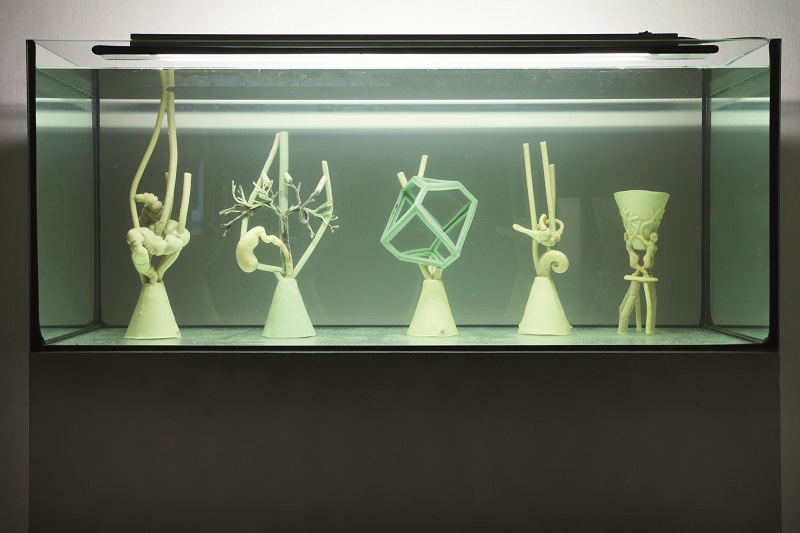
To recapitulate, in your view the different roles people take go along with different codings − or one could say: shifts in meaning − of the body. Does the same apply when dealing with dead bodies?
Yes, but within certain limits. As for living bodies, there is always the aspect of interaction, of seeing and being seen, of designating and being designated. Of course this doesn’t work with dead bodies.
A dead body, like that of a deceased relative, no longer acts according to a logic that can be explained and influenced through dialogue, nevertheless it is not possible to just put it aside like an object because it still concerns the other family members. In her essay Power of Horror – An Essay on Abjection (Columbia University Press, New York, 1982), Julia Kristeva introduces the term “abject” to describe this state that can be regarded neither as a responsive subject nor as a manageable object. This means that dead bodies need to be transformed to enable new ways of handling them. They are, as it were, redefined: through social conventions, through rituals. I am talking about a body which by means of recoding is turned into an ancestral body.
How does this recoding work in concrete terms? Are you talking about interventions such as embalming the body or the funeral?
Yes, but I’m also talking about the small acts that precede the actual funeral. In our culture, these include, amongst others: closing the eyelids, tying the jaw to keep it from dropping, opening a window, covering the mirror.
As an artist, do you take a particular interest in the culturally specific forms of dealing with the dead, hence also with dead bodies?
I’m particularly fascinated by the diversity of these forms − which may extend to contrariety. No culture allows the dead to be left to themselves; except, perhaps, in the event of extraordinary circumstances such as natural disasters or war. In every culture there are rules or rituals for dealing with the dead that also serve to prevent the spread of disease.
Most of the time there’s a link between hygienic necessities and religious meanings. Amongst the aspects repeatedly found are the retention of anything that reminds us of the dead person and the choice of a place to worship the dead where a controlled relationship can be maintained between the living and the dead − neither too close nor too distant. Taking these aspects as a starting point, it’s only one step away from recoding a body as a cultic object.
Could you please give us some examples.
I’m thinking here of such things as the relics you find in a lot of Catholic churches: like bone splinters or body parts of saints and martyrs preserved in preciously decorated containers. In Jerusalem, there’s a church built around the site of a tomb that possibly contains the remains of Jesus − a box within another box within yet another box. The body part sits there like a holy thorn in the flesh of the body of the church. There are strict controls on who has access to this place and how deeply they can penetrate.
There is, of course, also the body that has been extracted from its cultural context, that has been stolen. This object − a shrunken head, for example − is no longer treated as it would be in its original setting, but is preserved by representatives of a different culture in a museum display cabinet as a token of their superiority or proof of their own sophistication.
Such a body part undergoes a further encoding: while still a cultic object, it has now also become a collection object. Sometimes there are notes on the side of the glass cabinet documenting the different locations the object has been preserved in: postmarks from different post offices, seasons, signatures of former owners. These inscriptions all participate in rewriting the history of the body, imbuing it with new meaning.
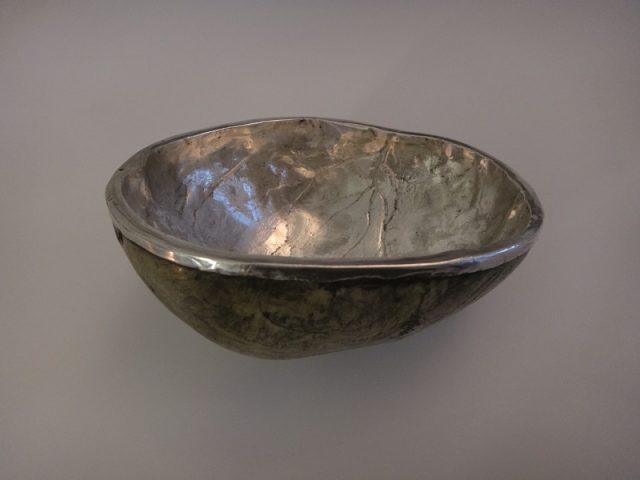
Would you say that you use your art to make people aware of such inscriptions made on bodies or body parts as well as a means of criticising certain inscriptions?
I’m not sure. Of course I hope that the questions I ask myself are just as apparent and relevant to the viewers of my works. Then again, my works are not about voicing outright criticism − they’re meant more as an expression of reflected inquiry, and are themselves still in the process of evolving, of seeking. I build correspondences between realms of association and problematic contexts, all of which also involve me personally.
Beside the wax works, my exhibition in Erlangen included a slide projection, in which I tried to address a particular collection object that in a circuitous fashion had come into my possession. The object in question is a kapala, a skull cup coated with a thin layer of silver that was and still is used during Tantric rituals (from the 7th/8th century onwards), mainly in Tibet and India.
During my visit to the Anatomical Museum I was struck by several skull cups because their bone plates or venous vessels are highlighted in colour. I saw these skulls as a challenge to apply my attention to my own kapala that had previously remained hidden at the bottom of some drawer, never having given any thought to how its existence might be linked with mine or vice versa.
The use of kapalas is subject to strict rules. In her work Tibetan Mahayoga Tantra – An Ethno-Historical Study of Skulls, Bones and Relicts (B.R. Publishing Corporation, New Delhi, 2008), the Tibetologist Dr. Andrea Loserick-Leik extensively describes the rules and functional modes for kapalas that are mostly used during ritual sacrifices. Just to give you an example: when a Tibetan Buddhist happens to find a kapala, the first thing he does is to go to a priest, a so-called Lama, who performs a strictly regulated ceremony to ascertain whether the skull cup and its finder stand in a positive karmic relation to each other, otherwise the kapala might cause serious damage.
How would you describe your artistic approach to the kapala?
I’ve put aside all rules regarding the treatment of a kapala as a cultic object or as a collection object and have assimilated it as artistic material. Over a period of two days I painted its interior, a process during which I regularly documented the different steps of my painting with photographs. There was no pre-determined dramaturgy whatsoever, I just proceeded intuitively while responding to the topology of the fine structures, lines and veins in the bone relief that showed through the thin layer of silver. I added elements, wiped away certain parts of the painting, supplemented, and created colour highlights. This open process led to ever new motifs and constellations on the inside of the skull. It had an almost hypnotic effect on me: eventually there was nothing but the skull and myself and the colour in between, not to forget the camera I had to handle simultaneously.
In summary, could we say that in the exhibition Gespinste at the Anatomical Institute you confronted the recoding of the body as a scientific object with a different recoding of the body?
Absolutely. By incorporating the artistic works into the scientific objects these were confronted with their own semantic space of culture, religion and ethics.
Similar to organs immersed in formalin, I presented the Galateas in large glass containers filled with water, whereas the slide projection Gespinst − Interweavings was displayed on a transparent foil I had attached on the inside of one of the collection’s glass cabinets. Only on closer examination did the visitors become aware that something was odd, that the collection also contained objects that didn’t belong there. Information labels eventually helped viewers find their orientation.
I think this kind of disconcertedness is a way of calling attention to partially contradictory levels of meaning and encodings of bodies. Which brings me straight to the concept of a historically contingent and boundless body.
Anna Lena Grau, thank you very much for this stimulating conversation.
Translation: Romy Fischer.
How to cite this article
w/k-Redaktion (2016): Anna Lena Grau: Recodings. w/k–Between Science & Art Journal. https://doi.org/10.55597/e1507
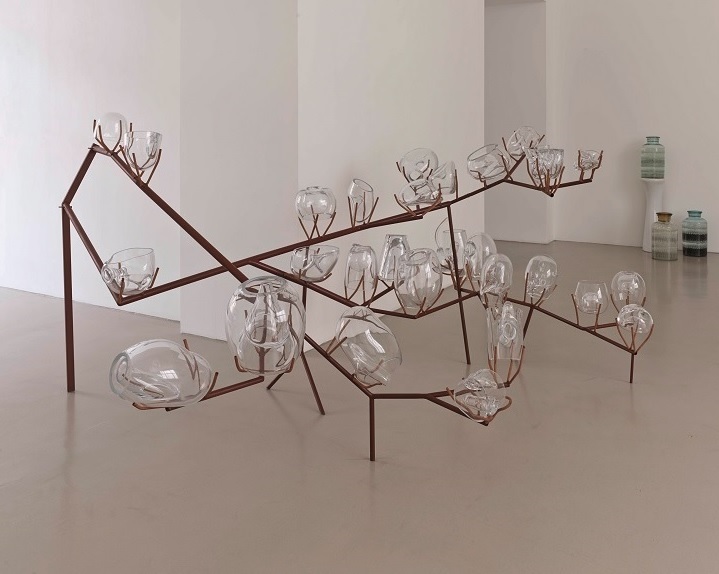
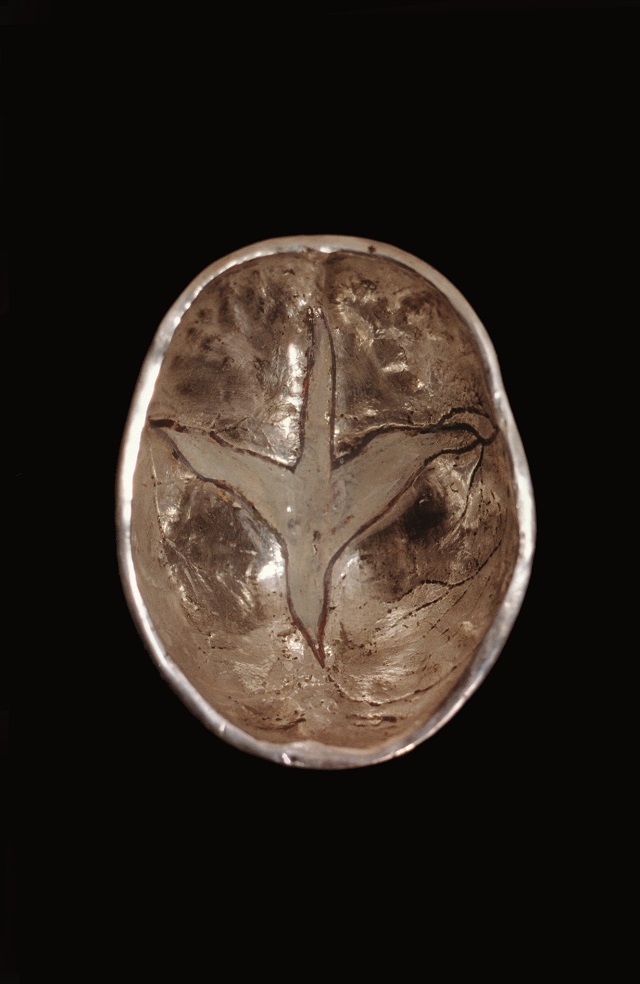
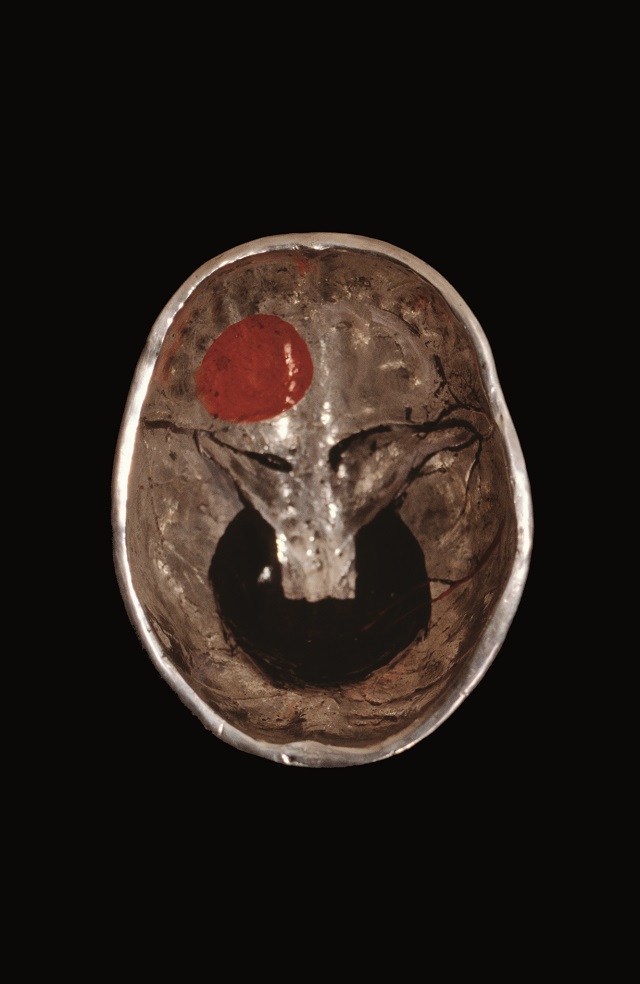
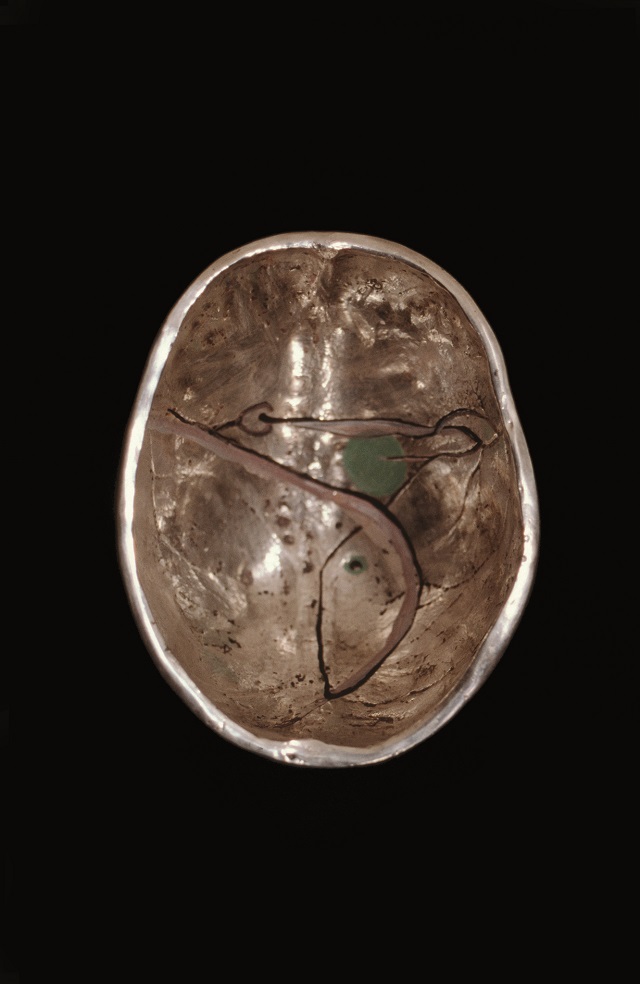
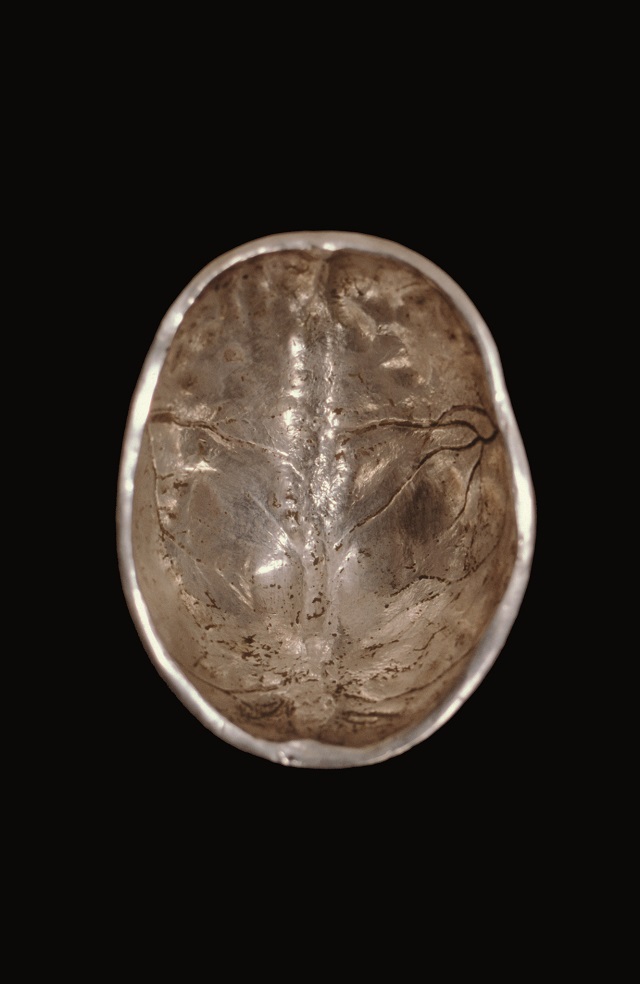

Be First to Comment